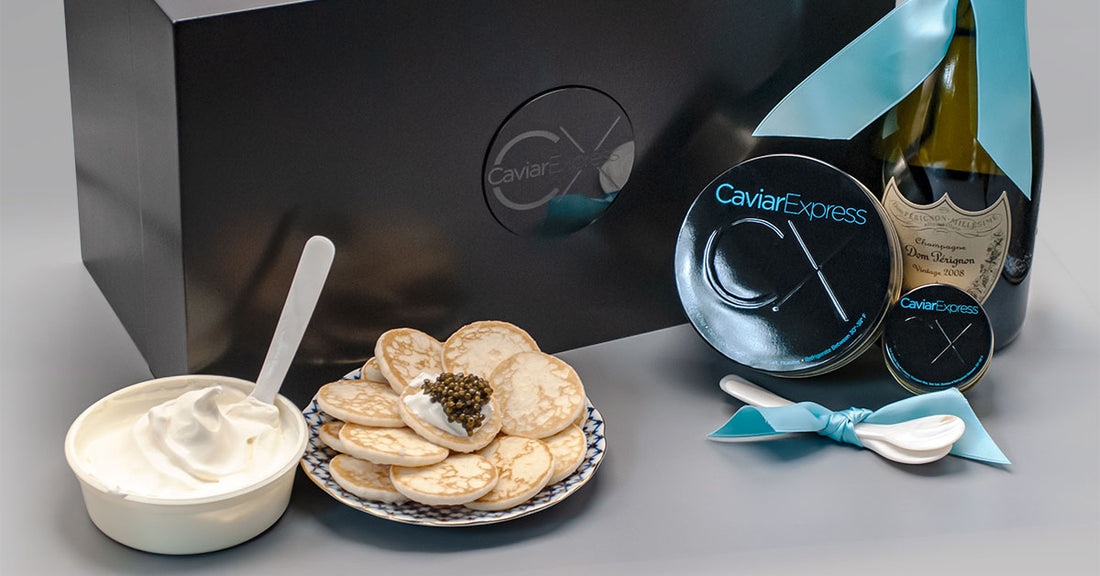
Why is caviar so expensive?
Share
For caviar connoisseur like most existing Caviar Express customers, "why is caviar so expensive" isn't hard to answer. It's an exquisite, refined food reserved historically for fine dinning of the most discerning taste buds. Like other luxury food products, such as Kobe beef or ōtoro sushi, it isn't expensive just for expensive sake. We'll go in depth on the reasons why true caviar is such a luxury food to be consumed on special occasions.
An unique, refined taste
First, let’s briefly define true caviar is. You may see other types of “fish eggs” sold on the market as caviar, but true caviar can only come from sturgeon eggs. Like the aforementioned luxury food products, sturgeon caviar has a unique, distinct taste unlike typical fish egg products.

Sturgeon, a critically endangered fresh water fish species, produce eggs that vary in color from black to a greenish-yellow hue, with a nutty, smooth buttery finish not unlike a fine foie gras, but the popping texture of the eggs provide a different dimension to the experience. The salty, faintly fishy taste as you press the caviar against your palate hits your taste buds like few other food can achieve.
And like wagyu or kobe beef, the smooth flavor should leave a pleasant aftertaste in your mouth. When paired with the right adult beverage the experience of eating caviar should be unique, luxurious, with a hint of extravagance.
But why is it so expensive?
You may be tempted to think that, as we mentioned before, that the sturgeon being a critically endangered species makes caviar rare, and therefore expensive. And while the rarity of the harvest is part of the reason, there are other factors that makes caviar such a luxury item.
Beluga sturgeons are critically endangered
Wild beluga sturgeons are in fact, critically endangered. Very little of its eggs can be legally harvested and sold. Plus, there are only a short period of time where they can be legally harvested AND beluga sturgeons can only be found near the Caspian and Black Sea makes for a small quantity of wild beluga caviar to be available every year.
Similar to kobe beef, or fine cognac, each of these delicacies can only come from a small region in the world from a specific stock.
Sturgeons live for a LONG time
Sturgeons can live for more than a hundred years. Beluga sturgeons can take up to 10 years to mature and produce eggs. Each annual brood will not produce caviar for up to a decade, and even then, once harvested, the female sturgeon will be taken out of the breeding population.
Even with sustainable farming, the yield for caviar is low and takes a very long time. See video below for how caviar farming works.
You can get both wild caviar and farmed caviar from Caviar Express.
Not ALL sturgeon eggs are the same
Every caviar harvest results in caviars of different grade. Each sturgeon produces different eggs. Larger, firmer eggs with more mild fish flavor are rarer and has a better tasting experience. But there’s no way to find out which grade of caviar each sturgeon produces until they’re harvested.

So on top of a rare breed, long gestation cycles, limited harvest season, small region of availability, and the uncertainty of each harvest, it’s no wonder caviars are ranked amongst the likes of white truffle as a delicacy worthy of royalty.
It’s not expensive for expensive sake
If you’ve ever had ōtoro or real kobe beef, you know they are indeed out of this world culinary experiences, with depth of flavor and melt-in-mouth texture that is unmatched by other cuts of the tuna or different steak from an ordinary cattle. And just like your all-you-can-eat sushi restaurant in the strip mall across the street isn’t likely going to be serving you the best fatty tuna, or your local MacDonalds won’t have real kobe beef patties in their burgers, you can’t just buy caviar from your local mass market grocery store. Because of the unique taste and the rarity and difficulty of harvest, your average $20 a tin “caviar” isn’t likely going to be real caviar.
But like buying a performance car, you’re not paying extra for a Koenigsegg or Pagani because they’re rare and hand-built. You’re paying extra for them because they’re engineering marvels and packed full of performance, luxury, and status unavailable to your average BMWs or Porsches. Unlike Koenigseggs, Paganis, or even Ferrari’s and Lamborghinis though, you don’t have to wait 3 years just to custom order one, nor do you need 6 figures to enjoy the taste of caviar. A small 2 oz tin is just right for a romantic dinner for 2, a 4.5oz tin is enough to sample between a small family of 4, and a 9 oz tin can liven up a decent sized dinner party. Even a 1 kg tin for a celebratory banquet can make it a truly memorable experience. Unlike a top-end überexotic, a caviar gift basket makes for a perfect gift for someone else to enjoy on their special birthday, anniversary, or even as a house warming gift.
Caviar Express carries the highest end Volga Reserve grade Ossetra caviar, to the uniquely flavored Iranian Karaburun Ossetra caviar, to reasonably priced, sustainably farmed American Sturgeon caviar for a wide range of budget. You can enjoy caviar for a little more than the cost of a night out for two, or splurge and treat a special someone to a grand caviar tasting party.

